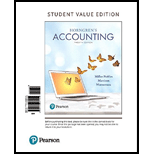
Concept explainers
Applying the allowance method to account for uncollectibles
| Learning Objective 3 |
The
a Sales revenue on account. $273,400 (ignore Cost of Goods Sold).
b Collections on account. $223,000.
c Write-offs of uncollectibles, $5,900
d. Bad debts expense of $5200 was recorded
Requirements
1 Journalize Signature Lamp Company’s transactions for 2018 assuming Signature Lamp Company uses the allowance method.
2
3. Show how accounts receivable would be reported on the
Want to see the full answer?
Check out a sample textbook solution
Chapter 9 Solutions
Horngren's Accounting, Student Value Edition (12th Edition)
- Discuss the accounting treatment for investments in debt and equity securities.arrow_forwardSaved Required information [The following information applies to the questions displayed below.] On December 1, Jasmin Ernst organized Ernst Consulting. On December 3, the owner contributed $84,310 in assets to launch the business. On December 31, the company's records show the following items and amounts. $ 10,200 Cash withdrawals by owner Cash Accounts receivable 15,200 Consulting revenue Office supplies 3,550 Rent expense Land 45,990 Office equipment 18,310 Accounts payable 8,740 Salaries expense Telephone expense Miscellaneous expenses Owner investments 84,310 $ 2,340 15,200 3,910 7,350 790 610 Use the above information to prepare a December 31 balance sheet for Ernst Consulting. AC Graw Hill ERNST CONSULTING Balance Sheet December 31 $ 0 G-SYNC $ 0 S 0 Barrow_forwardAudit, Fraud, Or Forensic Accounting Introduce yourself to your peers by sharing something unique about your background. Explain how you expect this course will help you move forward in your current or future career. This course covers forensic accounting, so it's important to establish the differences between an audit, a fraud examination, and a forensic accounting engagement. Think about the fraud conviction of Elizabeth Holmes, as described in the video, "Elizabeth Holmes Found Guilty in Theranos Fraud Trial." Then respond to the following: Imagine you are assigned to the Theranos case. Write the first five questions you would ask if you were an auditor, the first five questions as a fraud examiner, and the first five as a forensic accountant. After your questions, explain why the questions and approaches are different among the three roles. Be sure to respond to at least one of your classmates' posts.arrow_forward
- Degregorio Corporation makes a product that uses a material with the following direct material standards: Standard quantity 2.7 kilos per unit Standard price $9 per kilo The company produced 5,700 units in November using 15,760 kilos of the material. During the month, the company purchased 17,830 kilos of direct material at a total cost of $156,904. The direct materials purchases variance is computed when the materials are purchased. The materials quantity variance for November is: a. $3,330 F b. $3,236 F c. $3,330 U d. $3,236 Uarrow_forwardNonearrow_forwardGeneral Accountarrow_forward
 College Accounting (Book Only): A Career ApproachAccountingISBN:9781305084087Author:Cathy J. ScottPublisher:Cengage Learning
College Accounting (Book Only): A Career ApproachAccountingISBN:9781305084087Author:Cathy J. ScottPublisher:Cengage Learning College Accounting (Book Only): A Career ApproachAccountingISBN:9781337280570Author:Scott, Cathy J.Publisher:South-Western College Pub
College Accounting (Book Only): A Career ApproachAccountingISBN:9781337280570Author:Scott, Cathy J.Publisher:South-Western College Pub Financial Accounting: The Impact on Decision Make...AccountingISBN:9781305654174Author:Gary A. Porter, Curtis L. NortonPublisher:Cengage Learning
Financial Accounting: The Impact on Decision Make...AccountingISBN:9781305654174Author:Gary A. Porter, Curtis L. NortonPublisher:Cengage Learning


